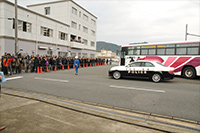|
Safety Targets |
Results |
|
1. Reduction of accidents for which the Nishitetsu Group is responsible: Reduction of at least 15% from the FY2023 reduction target |
(24.0%) |
|
2. Decrease in the number of accidents for which the Nishitetsu Group is responsible, based on Article 2 of the Automobile Accident Reporting Regulations: 6 or less |
3 cases |
|
3. Zero accidents with pedestrians at crosswalks |
2 cases |
1. To reduce the number of accidents at intersections to zero, we will ensure that our vehicles stop at yellow lights and make a "yellow (temporary) stop" when turning right or left at crosswalks to check for pedestrians.
2. To reduce the number of accidents resulting in injury to passengers to zero, we will ensure that all drivers onboard checks before departure and maintain a safe distance between vehicles and check the movement of vehicles around and in front of them and safety checks when opening and closing doors.
3. As part of our drive to prevent health-related accidents, we will conduct brain MRI/MRA examinations of highway bus crew members who have reached the age of 43.
Since 1969, the bus division has been running the “Perfect Transportation Campaign,” a small-group activity aimed at achieving zero accidents. In this exercise, crew members are divided into small groups to hold discussions, in which they themselves point outproblems in dealing with customers and safety, think of solutions, implement them, and check them themselves in order to come up with better countermeasures. In addition, we aim to send customers to their destinations “safely, reliably, and kindly” through a perfect transportation campaign with the “goal of improving customer service.”
Practical training based on the scenario of a bus hijacking is held annually within the Nishitetsu Bus Group. In addition, the vehicles are equipped with an SOS indicator on the rear-facing curtain, and express buses are equipped with a GPS-based emergency call system, so that in the event of an emergency the operating office, head office, and police can cooperate to respond.

IT equipment is being utilized to further improve the quality of instruction and education for crew members.
Images and sound are recorded at all times while vehicles are operating.
All Nishitetsu Bus Group vehicles are equipped with this system. Utilizing recorded driving behavior, etc., data on “near-misses” are collected and discussions are held on how to make driving safer.
The collected data is also used for accident prevention through the “Safety Information-Sharing Portal,” a system that enables users to search for necessary information whenever they need it.

- 拡大
- (1) Recording by a drive recorder


- 拡大
- (2) Video analysis


- 拡大
- (3) Driving guidance based on analysis
This device enables data analysis of the driver’s operation (speed, engine RPM, etc.) and provides more specific guidance on safe driving and environmentally friendly driving. The system has been installed in all Group vehicles.
Cellular phones are turned off while crew are on duty and are kept in a designated storage area.

- 拡大
- (1) Turn off the power and put it in the pouch.


- 拡大
- (2) Zip it up and put it on the shelf.


- 拡大
- (3) Keep the pouch from falling off
While driving, millimeter-wave radar and image sensors detect and analyze the area in front of the vehicle, and if the distance falls below a safe distance, an alarm or automatic braking system is activated to alert the driver. Furthermore, when the likelihood of a rear-end collision is high, the brakes are activated more strongly to reduce the collision speed and mitigate damage. The Nishitetsu Group has begun installing these systems in highway buses introduced in and after FY2011, and as of the end of FY2024, 323 buses (223 by Nishitetsu itself and 100 by Group companies) are equipped with these systems.
*Installation of this device is mandatory for highway buses manufactured in and after November 2014.

A monitoring camera constantly checks the driver's posture, face direction, and eyelid opening/closing status while the vehicle is in motion, and alerts the driver if it detects a lack of forward attention. As of the end of FY2024, the system has been installed in 58 route buses (48 by Nishitetsu itself and 10 by Group companies) and 239 highway buses (165 by Nishitetsu itself and 74 by Group companies).


In the event of a crew member's sudden medical or other emergency, the bus will start braking when the crew member presses the driver's seat switch or a customer presses the switch located above the passenger seats. At the same time, an emergency buzzer will sound inside the car, the lamps built into the passenger seat switches will flash, and the red flashing light will flash to notify passengers. As of the end of FY2024, the system has been installed in 99 route buses (84 by Nishitetsu itself and 15 by Group companies) and 95 highway buses (63 by Nishitetsu itself and 32 by Group companies).



An image sensor mounted in the cabin detects the vehicle's position relative to the lane, and warns the driver with an audible alarm and on-screen display if the vehicle deviates from its lane. As of the end of FY2024, the system has been installed in 287 highway buses (203 by Nishitetsu itself and 84 by Group companies)



Using millimeter-wave radar, the system alerts the driver with a warning display on the driver's multi-information display and an audible warning when the distance from the vehicle in front becomes less than the safe distance. As of the end of FY2024, the system has been installed in 312 highway buses (221 by Nishitetsu itself and 91 by Group companies).
